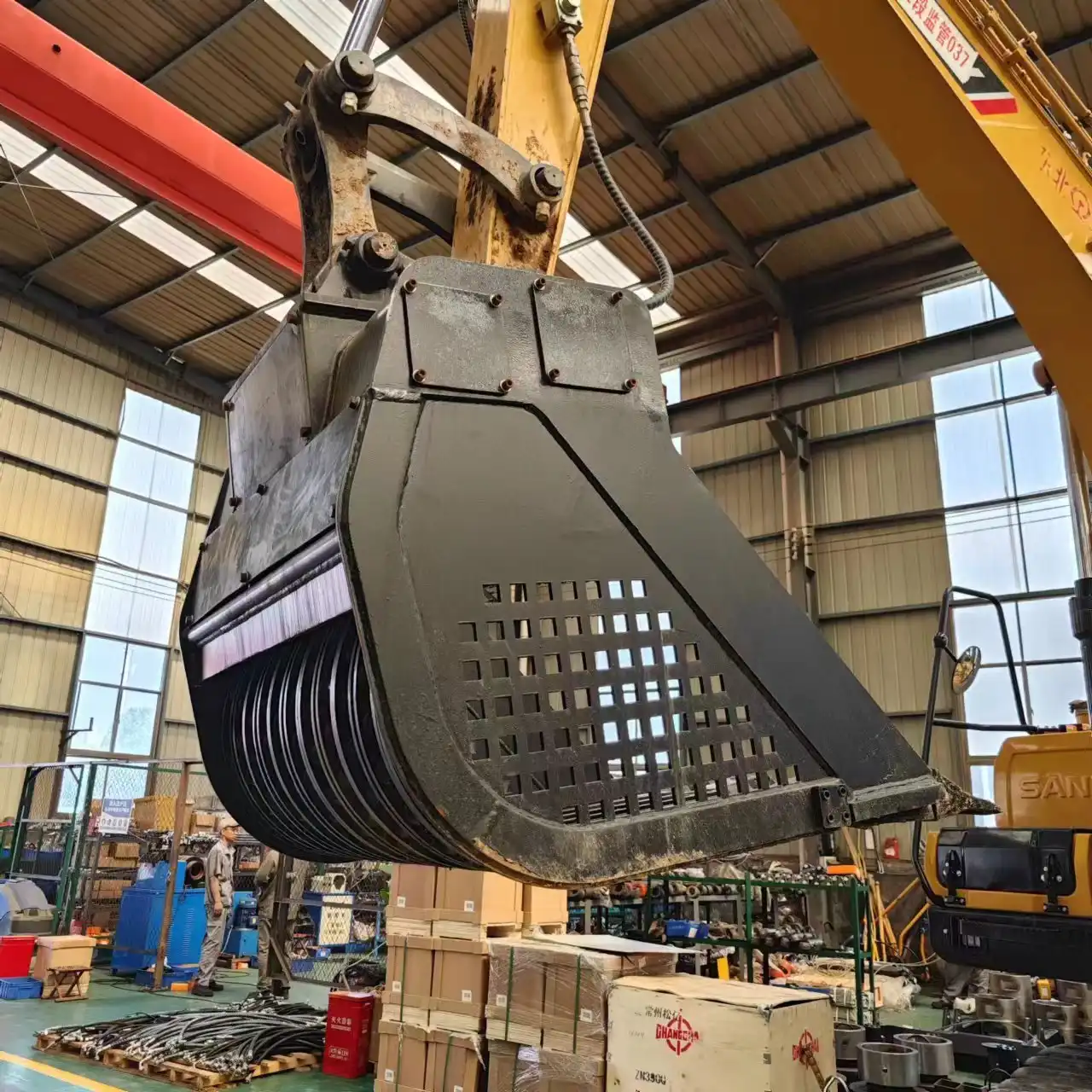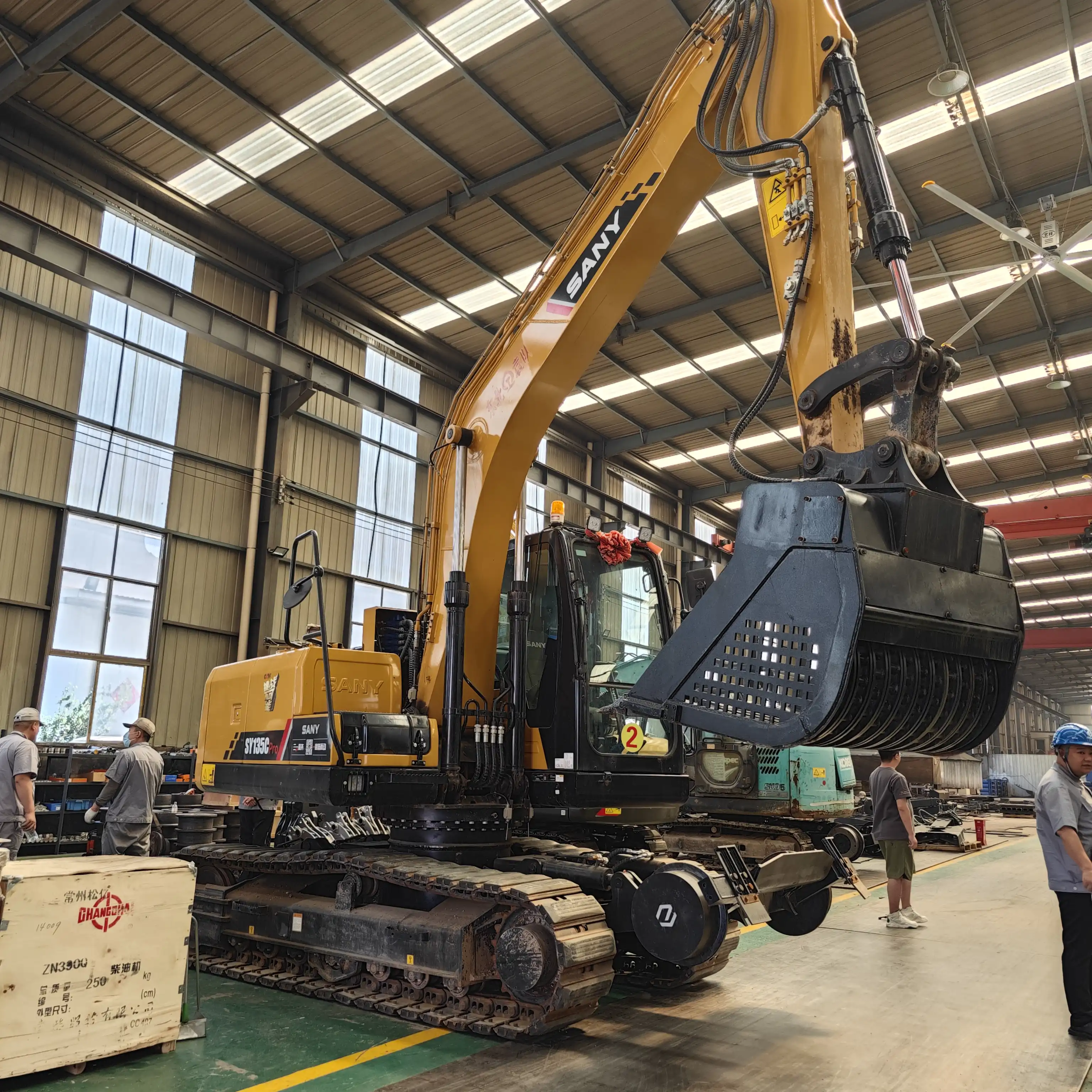How Do Hydraulic Screening Buckets For Excavators Work?
Hydraulic screening buckets for excavators represent an advancement in material processing technology. These specialized attachments transform standard excavators into efficient sorting machines, significantly enhancing productivity across construction, demolition, and recycling operations. The excavator screening bucket works through an ingenious hydraulic-powered mechanism that separates materials by size directly at the worksite, eliminating the need for separate screening equipment and additional material handling. By connecting to an excavator's existing hydraulic system, these attachments create a powerful vibrating or rotating action that forces smaller particles through precisely sized mesh openings while retaining larger materials.
Material Loading

Loading Process
The initial step in utilizing an excavator screening bucket involves properly loading the attachment with mixed materials that require separation. Unlike conventional excavator buckets that simply scoop and transport, screening buckets must be filled strategically to ensure optimal screening efficiency. Operators typically gather materials by positioning the bucket flat against the ground and using a forward scooping motion. The high-strength steel construction of quality buckets, like those manufactured by Tiannuo with capacities ranging from 0.3 to 3.0 m³, ensures durability even when handling abrasive or heavy materials such as demolition rubble, quarry materials, or rocky soil.
The loading technique varies based on material composition and moisture content. Drier materials flow more freely through the screening mechanism, while material with higher moisture content may require more vigorous agitation. In many applications, operators develop a rhythm of loading partial buckets rather than filling to capacity, which allows for more thorough screening as materials have sufficient space to move within the bucket during the separation process. This methodical approach prevents overloading, which could compromise screening efficiency and potentially damage the hydraulic mechanisms.
Material Compatibility and Considerations
Not all materials are equally suitable for processing through an excavator bucket attachment. Understanding material compatibility is crucial for both operational efficiency and equipment longevity. These attachments excel at processing:
- Topsoil and compost for landscaping projects
- Construction and demolition waste for recycling
- Gravel and stone for drainage applications
- River sediment and beach sand for environmental remediation
- Quarry byproducts for material recovery
However, certain materials present challenges. Extremely cohesive clay-rich soils may clump together and resist separation unless properly dried. Similarly, materials with high organic content, like root-filled soil, may wrap around moving parts and require frequent cleaning. Modern screening buckets incorporate design features to address these challenges, such as self-cleaning mechanisms and replaceable wear parts that extend service life when processing abrasive materials.
Hydraulic Activation

How Hydraulic Power Transfer Works
The heart of an excavator screening bucket's operation lies in its hydraulic activation system, which harnesses the excavator's existing hydraulic infrastructure to generate the mechanical action required for material separation. This integration is accomplished through hydraulic quick-connect couplings that tap into the excavator's auxiliary hydraulic circuit, redirecting pressurized hydraulic fluid to power the screening mechanism. Most modern screening buckets require hydraulic flow rates between 20-50 liters per minute at 150-250 bar pressure, depending on bucket size and design. This relatively modest hydraulic requirement means these attachments can be utilized even on mid-sized excavators without overtaxing the machine's hydraulic capacity.
Inside the screening bucket, this hydraulic pressure activates either rotary motors or oscillating valves that transform hydraulic energy into mechanical movement. In rotary drum designs, the hydraulic motor drives a central shaft connected to an eccentric weight system that generates controlled vibration frequencies. Vibrating screen configurations employ multiple hydraulic actuators positioned strategically to create bidirectional or circular movement patterns that maximize material agitation without excessive stress on the bucket structure. The most sophisticated models feature adjustable hydraulic settings that allow operators to modify vibration intensity and pattern based on material characteristics, enhancing screening precision across varying applications.
Types of Screening Mechanisms
The market offers several distinct types of hydraulic activation mechanisms, each optimized for specific applications and material types:
Rotary Drum Systems - Feature a cylindrical drum with perforated walls that rotates through hydraulic power. The drum rotation creates a tumbling action that progressively separates materials through the perforations. These systems excel at processing rounded materials like river rock and are less prone to clogging when handling materials with moderate moisture content.
Vibrating Plate Designs - Utilize flat screening surfaces with customizable grid patterns that vibrate at high frequencies. The vibration creates thousands of micro-movements that progressively work smaller particles through the screen while larger objects remain above. This design typically achieves higher throughput rates for drier materials and provides exceptional separation accuracy.
Star Screen Technology - Employs rotating shafts with star-shaped discs that create a self-cleaning screening surface ideal for materials with higher organic content or moisture levels. The rotation of these interlocking stars prevents material buildup while providing consistent sizing.
Finger Screen Configurations - Incorporate parallel bars with adjustable spacing that vibrate to allow material flow-through while retaining oversized objects. These systems offer outstanding performance in heavy-duty applications like processing demolition concrete or asphalt chunks.
The screening bucket attachmentsmarket continues to evolve with technological advancements aimed at increasing efficiency and durability. Tiannuo's engineering team has focused on creating hydraulic systems that deliver consistent performance while minimizing energy consumption, helping contractors reduce fuel costs during extended screening operations.
Size Separation

Material Separation
The fundamental principle behind excavator screening bucket functionality is mechanical separation based on particle size. This process occurs as materials interact with precisely engineered screen meshes or grid systems that function as physical barriers, permitting only appropriately sized particles to pass through. The screening action occurs across three distinct zones within the bucket: the feed zone, where material initially contacts the screen surface, the separation zone, where the majority of properly sized material passes through, and the discharge zone, where oversized materials exit the screening process.
The effectiveness of this separation depends on several scientific factors. Screen aperture geometry significantly impacts throughput rates and separation accuracy, with square openings (like Tiannuo's customizable 55×55 mm configuration) providing balanced performance across various materials. Material presentation angle, the way particles approach the screen surface, affects both separation efficiency and screen wear patterns. The ratio between particle size and opening size, known as the "near-size particle factor," becomes particularly important when processing materials with high percentages of borderline particles that are just slightly larger or smaller than the screen openings.
Production Rates and Efficiency Factors
The throughput capacity of hydraulic screening buckets varies significantly based on multiple variables. Under optimal conditions with free-flowing materials like dry sand or gravel, production rates can reach 15-25 cubic meters per hour for mid-sized buckets. However, several factors influence actual field performance:
Material Characteristics - Moisture content dramatically affects screening efficiency, with production rates potentially decreasing by 30-50% when processing wet or sticky materials. Particle shape also impacts throughput, as angular materials tend to interlock and require more aggressive agitation compared to rounded particles.
Screen Configuration - Opening size directly correlates with production rates; larger openings allow faster material passage but reduce separation precision. The proportion of screen surface area to bucket volume, known as the "screening area ratio," serves as a critical design parameter that balances throughput against bucket weight and structural integrity.
Operator Technique - Skilled operators develop techniques that maximize production while maintaining separation quality. This includes optimal bucket positioning during the screening cycle, appropriate dwelling time to ensure complete material processing, and strategic pattern movement that promotes even material distribution across the screen surface.
Hydraulic Parameters - Adequate hydraulic flow and pressure ensure the screening mechanism operates at designed frequencies and amplitudes. Insufficient hydraulic power leads to reduced agitation and lower throughput, while excessive hydraulic energy can accelerate wear on bucket components.
By optimizing these factors, contractors utilizing excavator screening buckets can achieve significant productivity improvements compared to traditional screening methods while maintaining precise material specifications required for quality-controlled applications.
FAQ
①What maintenance is required for hydraulic screening buckets?
Regular maintenance of excavator screening buckets includes inspecting hydraulic connections for leaks, lubricating moving parts per manufacturer's specifications, checking screen mesh for damage or clogging, and examining structural components for wear. Most manufacturers recommend daily visual inspections and weekly lubrication of key pivot points. High-quality buckets constructed from high-strength steel, like those from Tiannuo, typically require less frequent maintenance due to their durable construction and wear-resistant components.
②Can screening buckets process wet materials?
While excavator screening buckets can process materials with moderate moisture content, performance decreases as moisture levels increase. Wet materials tend to clump together and may clog screen openings, reducing throughput and separation efficiency. Many modern buckets incorporate self-cleaning mechanisms or vibration patterns specifically designed to minimize clogging when processing damp materials. For consistently wet applications, operators might consider models with specialized screen designs or increased vibration intensity to maintain productivity.
③What determines the right screen size for my application?
Selecting the appropriate screen mesh size depends primarily on your desired end product specifications. Finer meshes produce cleaner, more precisely graded materials but reduce processing speed. Common applications like topsoil preparation typically utilize 25-35mm openings, while coarser applications like primary demolition waste sorting might use 50-75mm screens. Tiannuo offers customizable grid spacing to match specific project requirements, ensuring optimal performance across various material processing needs.
About Tiannuo
Tiannuo's commitment to engineering excellence is evident in their excavator screening bucket lineup, featuring high-strength steel construction, universal mounting brackets for cross-fleet compatibility, and customizable grid spacing to meet diverse application requirements. Their buckets deliver the durability required for demanding environments while maintaining the precision needed for quality-controlled material production. For construction professionals seeking to enhance operational efficiency while meeting tightening project specifications, hydraulic screening buckets represent a worthy investment in productivity and material quality control.
For additional information about Tiannuo's screening bucket options or to discuss specific application requirements, please contact us at tn@stnd-machinery.com.
References
Johnson, M. (2023). Advancements in Hydraulic Attachments for Modern Excavators. Construction Equipment Technology Review.
Zhang, L. & Williams, P. (2024). Comparative Analysis of Material Separation Technologies in Construction Applications. Journal of Construction Engineering.
Patel, S. (2023). Efficiency Metrics for On-Site Material Processing in Urban Construction Projects. Urban Development Studies.
Thompson, R. (2024). Sustainability Impact of On-Site Material Recycling in Demolition Projects. Environmental Construction Practices.
Robinson, K. & Chen, Y. (2023). Hydraulic System Integration for Specialized Excavator Attachments. Heavy Equipment Engineering Journal.
About Author: Arm
Arm is a leading expert in the field of specialized construction and railway maintenance equipment, working at Tiannuo Company.

